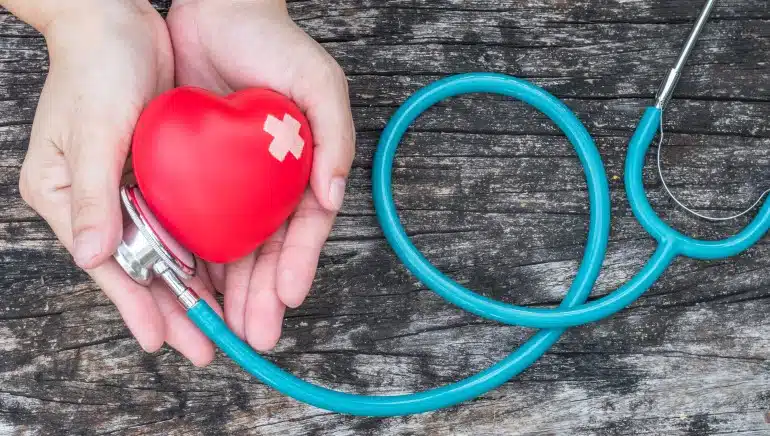Even at the young age of 27, I am at risk for heart disease due to a family history of heart attacks, high blood pressure, and diabetes.
People should begin keeping track of their risk factors in their early adult years, according to a cardiologist.
I should monitor my blood pressure and cholesterol, increase my physical activity, and keep quitting smoking to reduce my risk.

Each everyday, top editors send the articles you desire straight to your inbox.
As a health reporter, I covered American Heart Month in several of my pieces this past February. As a result, I made the unsettling discovery that, at the age of 27, I have a high risk of developing heart disease, the leading cause of death in the nation.
I’ve always known that there’s a history of health problems in my family. When I was eight years old, I recall driving to the hospital first thing in the morning after my grandma had a heart attack. I then observed her fingers’ tips deteriorate as a result of numerous blood sugar checks. And when I was 15 years old, my father removed the salt shaker from our dining room table while making a joke about the “hypertension,” which at the time sounded absurd.
But as a teenager, I was unable to understand that these symptoms were indicators that my family had heart disease, along with the condition’s frequent risk factors diabetes and high blood pressure. Even in my early 20s, I believed that dealing with “heart disease,” a general term that covers a variety of conditions like high blood pressure and heart attacks.
This month, I was able to connect the dots: I’m at risk for heart disease because of my family history. I discovered that people of my race—South Asians—have a disproportionately high chance of developing heart issues. In addition, scientists and cardiologists are now seeing more young people coming in with cardiac problems than I used to think, contrary to my naive idea that heart disease doesn’t manifest itself until mid-life.
I discussed my family history and lifestyle with Dr. Nilay Shah, a cardiologist at Northwestern University who is researching heart disease in young South Asian Americans, in order to help me and other 20-somethings in my situation reduce our risk. Finally, Shah urged everyone to start evaluating their heart health right away.
Early adulthood is the ideal moment for you to begin paying attention to your personal risk factors for heart disease, he advised.
My blood pressure, blood sugar, and cholesterol need to be constantly monitored since I have a high risk of developing heart disease.
Shah advised me to focus on reducing my risk of heart disease by lowering my blood pressure, blood sugar, and cholesterol levels.
It’s critical to check for these risk factors and discuss them with a doctor, according to Shah, “because it’s simpler to intervene early in those processes than later if they start to detect patterns moving in the wrong direction.”
Shah said that standard blood tests like a lipid panel, which evaluates my levels of “good” and “bad” cholesterol, and a haemoglobin A1C test, which gauges the amount of glucose in my blood over the preceding 12 weeks, may be necessary for screening for high blood sugar or diabetes.
Shah advised me to begin monitoring my blood pressure at home with a monitor that is available at CVS for about $40. He advised young folks to aim for blood pressure levels of 120/80 or lower.
I need to eat at home more frequently and prioritise working out every day.
According to Shah, routine blood tests like a lipid panel, which assesses my “good” and “bad” cholesterol levels, and a haemoglobin A1C test, which measures the amount of glucose in my blood over the previous 12 weeks, may be required for screening for diabetes or high blood sugar.
Shah suggested that I start checking my blood pressure at home using a device that costs around $40 and is available at CVS. Young people should aim for blood pressure readings of 120/80 or less, he said.
I should prioritise working out every day and eating at home more frequently.
Exercise can also lower my risk, and I realise that my on-again, off-again connection with it is insufficient.
Exercise reduces your risk of dying young from heart disease, according to numerous studies, and Shah said his research indicates that South Asian Americans generally don’t engage in enough physical activity.
Fortunately, the cardiologist advised that some exercise is preferable to none. Shah advised using the recommendation for 150 minutes of moderate to vigorous physical exercise per week as a goal to work towards rather than an all-or-nothing standard.
Exercise can also reduce my risk, and I’ve come to realise that my inconsistent relationship with it is insufficient.
Several studies have shown that exercise lowers your risk of dying young from heart disease, and Shah said his research shows that South Asian Americans in general don’t get enough exercise.
Thankfully, the cardiologist said that any amount of activity is better than none. Instead of treating the advice for 150 minutes of moderate to vigorous physical activity per week as an all-or-nothing norm, Shah suggested utilising it as a goal to work towards.
Also, exercise can lower my risk, and I’ve realised that my erratic relationship with it is insufficient.
Exercise has been linked to a decreased risk of heart disease-related early death, and according to Shah’s research, South Asian Americans as a whole don’t receive enough of it.
Fortunately, the cardiologist advised that any level of activity is preferable to none. Shah recommended using the recommendation for 150 minutes of moderate to vigorous physical activity per week as a goal to work towards rather than considering it as an all-or-nothing standard.
ALSO READ THIS: Why The Solar-Powered Automobile -Lightyear, Sion, And Aptera Is An Ideal

